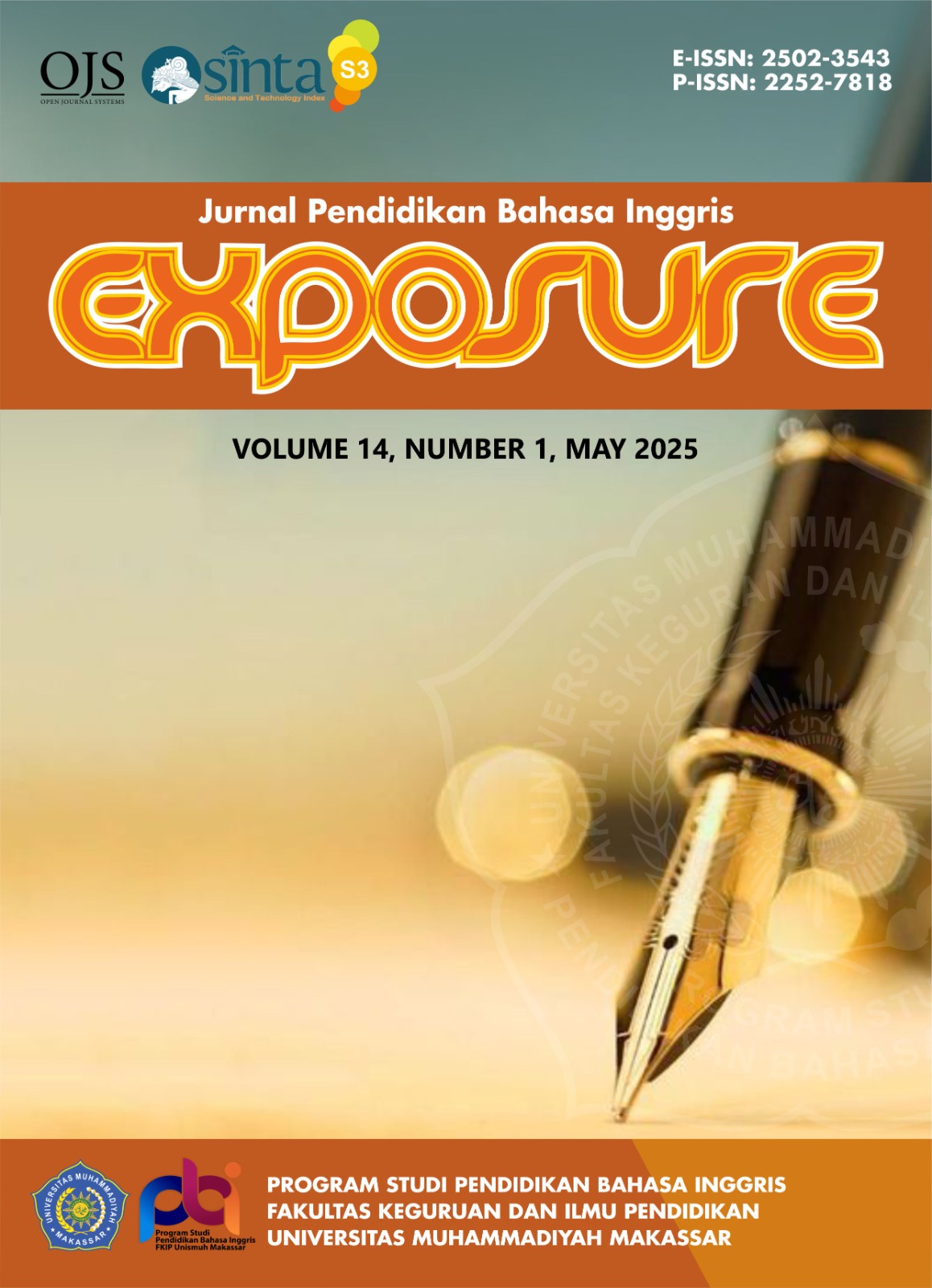IMPROVING PRONUNCIATION ABILTY FOR JUNIOR HIGH SCHOOL STUDENTS THROUGH HOMOPHONE GAME
DOI:
https://doi.org/10.26618/exposure.v14i1.14612Kata Kunci:
Improve, Pronunciation, Homophone GameAbstrak
The articulation of vowels is a cornerstone of phonological and linguistic studies, playing a critical role in understanding speech patterns and language acquisition. Influenced by factors such as tongue position, lip rounding, and phonetic context, vowel variation remains underexplored in the context of second language learning. To analyze The objective of this research was to illustrate that the inclusion of homophone game could improve the pronunciation skills of seventh grade students at SMPN 16 PALU. the researcher employed a quasi-experimental approach, assigning 31 students to the experimental group and 34 students to the control group. The sample was selected by using cluster random sampling technique. Data collection involved pre-test and post-test, an analyzed was conducted using paired sample t-tests with the assistance of SPSS version 27 windows. The findings indicate that employing the homophone game strategy effectively improved the pronunciation ability of the seventh-grade students at SMPN 16 PALU. this was evidenced by the paired sample t-test analysis, revealing a significance level (2-tailed) of 0.001 < 0.05, indicating a significant difference in students’ learning outcomes between the pretest and posttest phases. This discovery suggests that to improve pronunciation instruction, educators should integrate homophone games into their teaching approaches. Keywords: Improve, Pronunciation, Homophone Game
Referensi
Agustiana, W., Batau, S. H., & Rampeng. (2021). the Influence of Using “Hello English” Application Towards Students’ Pronunciation of the Eigth Grade At Smpn 1 Sumarorong. Klasikal : Journal of Education, Language Teaching and Science, 3(1), 41–51. http://journalfkipuniversitasbosowa.org/index.php/klasikal/article/view/92
Collins, B., & Rodd, J. (1972). English pronunciation problems of francophonic West Africans. ELT Journal, 27(1), 79–88.
Creswell, J. W. (2021). A concise introduction to mixed methods research. SAGE publications.
Gilakjani, A. P. (2012). The significance of pronunciation in English language teaching. English language teaching, 5(4).
Hornby, A. S. (n.d.). Oxford advanced learner’s dictionary of current English. Oxford: Oxford Univ. Press, 1974. 1055 p.
Kenworthy, J. (1987). Teaching english pronunciation. (No Title).
Kiswindari, C. (2018). Improving the students’ pronunciation through homophone game at the second grade students of SMA Asuhan Daya Medan. Medan. Thesis. State Islamic University of North Sumatera Medan.
Maulana, I., Lestiono, R., Wiraatmaja, T., & Gusdian, R. I. (2021). Arriving at pronunciation accuracy in singing English songs: Hijaiyah consonants as the mediation. Satwika : Kajian Ilmu Budaya dan Perubahan Sosial, 5(2), 303–316. https://doi.org/10.22219/satwika.v5i2.17666
Minh, N. T. H., & Giang, N. M. (2022). Using Homophone Games To Improve Pronunciation Performance For Non-English Majors. International Journal of Scientific and Research Publications (IJSRP), 12(5), 509. https://doi.org/10.29322/ijsrp.12.05.2022.p12562
Morley, J. (1998). Trippingly on the Tongue. ESL Magazine, 1(1), 20–23.
Pratiwi, D. (2019). The Use Of Homophone Game To Improve Students’ Pronunciation At The Seventh Grade of MTs Sidenreng Rappang. 37–38.
Syamsia, S., & Salamat, M. (2019). Using Homophone Game to Improve Students’ Pronunciation at Junior High School 5 of Tidore Archipelago. Langua: Journal of Linguistics, Literature, and Language Education, 2(1), 9–14. https://doi.org/http://doi.org/10.5281/zenodo.2588088
Yates, L., & Zielinski, B. (2009). Give it a go: Teaching pronunciation to adults. Adult Migrant English Program (AMEP) Research Centre, Macquarie University.
Unduhan
File Tambahan
Diterbitkan
Terbitan
Bagian
Lisensi
Authors who publish with this journal agree to the following terms:
In order to assure the highest standards for published articles, a peer review policy is applied. In pursue of the compliance with academic standards, all parties involved in the publishing process (the authors, the editors and the editorial board and the reviewers) agree to meet the responsibilities stated below in accordance to the Journal publication ethics and malpractice statement.
Duties of Authors:
- The author(s) warrant that the submitted article is an original work, which has not been previously published, and that they have obtained an agreement from any co-author(s) prior to the manuscript’s submission;
- The author(s) should not submit articles describing essentially the same research to more than one journal;
- The authors(s) make certain that the manuscript meets the terms of the Manuscript Submission Guideline regarding appropriate academic citation and that no copyright infringement occurs;
- The authors(s) should inform the editors about any conflict of interests and report any errors they subsequently, discover in their manuscript.
Duties of Editors and the Editorial Board:
- The editors, together with the editorial board, are responsible for deciding upon the publication or rejection of the submitted manuscripts based only on their originality, significance, and relevance to the domains of the journal;
- The editors evaluate the manuscripts compliance with academic criteria, the domains of the journal and the guidelines;
- The editors must at all times respect the confidentiality of any information pertaining to the submitted manuscripts;
- The editors assign the review of each manuscript to two reviewers chosen according to their domains of expertise. The editors must take into account any conflict of interest reported by the authors and the reviewers.
- The editors must ensure that the comments and recommendations of the reviewers are sent to the author(s) in due time and that the manuscripts are returned to the editors, who take the final decision to publish them or not.
Authors are permitted and encouraged to post online a pre-publication manuscript (but not the Publisher’s final formatted PDF version of the Work) in institutional repositories or on their Websites prior to and during the submission process, as it can lead to productive exchanges, as well as earlier and greater citation of published work (see The Effect of Open Access). Any such posting made before acceptance and publication of the Work shall be updated upon publication to include a reference to the Publisher-assigned DOI (Digital Object Identifier) and a link to the online abstract for the final published Work in the Journal.




